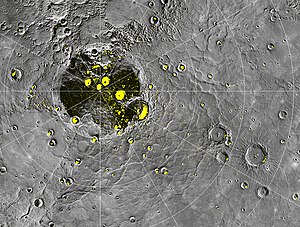
Back Quadrangle Borealis Catalan Quadrangle de Borealis French Maglia Borealis Italian 보렐리스 쿼드랭글 Korean Северный полюс Меркурия Russian



The Borealis quadrangle is a quadrangle on Mercury surrounding the north pole down to 65° latitude. It was mapped in its entirety by the MESSENGER spacecraft, which orbited the planet from 2008 to 2015, excluding areas of permanent shadow near the north pole. Only approximately 25% of the quadrangle was imaged by the Mariner 10 spacecraft during its flybys in 1974 and 1975. The quadrangle is now called H-1.[2]
It contains the Goethe Basin, whose diameter of at least 400 km (250 mi) makes it the sixth-largest impact basin observed on Mariner 10 images[3][4][5](Murray and others, 1974; Boyce and Grolier, 1977; Strom, 1977). The west half of the mapped area (between long 100° and 190° W.) is dominated by older craters and by intercrater plains material that lies between and within them. Younger crater materials, intermediate plains material, and small patches of smooth plains material are superposed on all other units. The crater Verdi, 122 km (76 mi) in diameter, is the largest of the younger craters. Its extensive ejecta blanket and secondary crater field are superposed on plains materials and older craters.
The east half of the mapped area (between long 0° and 100° W.) is characterized by smooth plains material[6] (Murray and others, 1974). This unit covers vast expanses of Borealis Planitia, a depression about 1,000 km (620 mi) in diameter that has an irregular arcuate west boundary. This depression is located over the site(s) of one or several old impact structures[5][6] (Boyce and Grolier, 1977).
Adjacent quadrangles to the south of Borealis are Victoria quadrangle (0° to 90° W), Shakespeare quadrangle (90° to 180° W), Raditladi quadrangle (180° to 270° W), and Hokusai quadrangle (270° to 0° W). It is opposite the Bach quadrangle at the south pole.
- ^ John K. Harmon, Martin A. Slade, Melissa S. Rice, 2011. Radar imagery of Mercury’s putative polar ice: 1999–2005 Arecibo results. Icarus, 211, p37-50. doi.org/10.1016/j.icarus.2010.08.007
- ^ Map of the H-1 (Borealis) Quadrangle of Mercury
- ^ Strom, R. G.; Trask, N. J.; Guest, J. E. (1975). "Tectonism and volcanism on Mercury". Journal of Geophysical Research. 80 (17): 2478–2507. doi:10.1029/jb080i017p02478.
- ^ Trask, N. J.; Guest, J. E. (1975). "Preliminary geologic terrain map of Mercury". Journal of Geophysical Research. 80 (17): 2461–2477. doi:10.1029/jb080i017p02461.
- ^ a b Strom, R. G. (1979). "Mercury: A post-Mariner 10 assessment". Space Science Reviews. 24 (1): 3–70. doi:10.1007/bf00221842.
- ^ a b Trask, N. J.; Strom, R. G. (1976). "Additional evidence of mercurian volcanism". Icarus. 28 (4): 559–563. Bibcode:1976Icar...28..559T. doi:10.1016/0019-1035(76)90129-9.